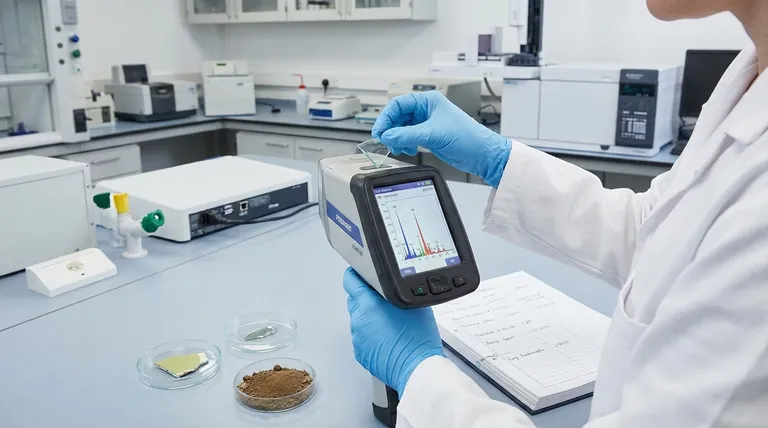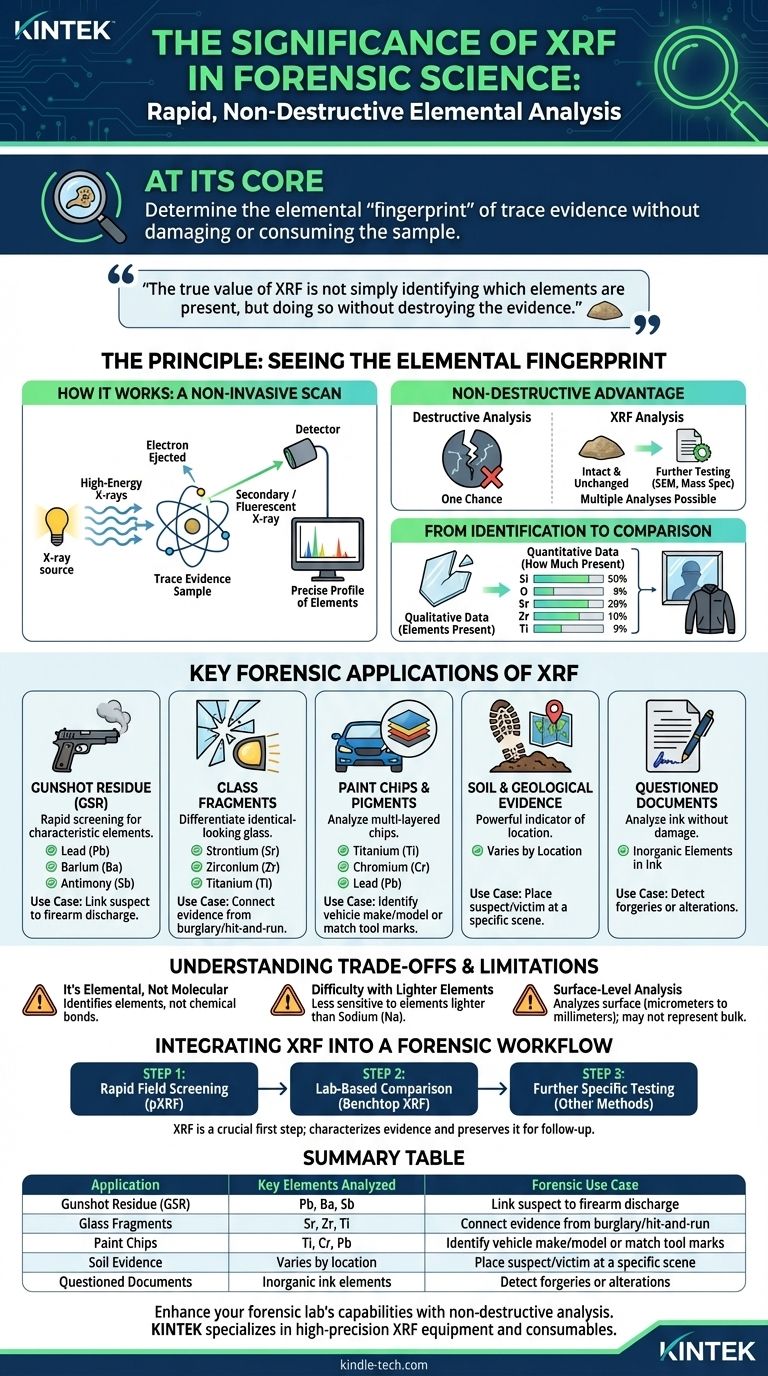At its core, the significance of X-ray Fluorescence (XRF) in forensic science lies in its ability to perform rapid, non-destructive elemental analysis. This allows investigators to determine the elemental "fingerprint" of trace evidence—such as a speck of glass or a chip of paint—without damaging or consuming the irreplaceable sample. This preserves the evidence for further testing while providing crucial data to link suspects, victims, and crime scenes.
The true value of XRF is not simply identifying which elements are present, but doing so without destroying the evidence. This non-destructive capability makes it an indispensable screening tool, guiding the entire analytical workflow and ensuring that critical samples can be re-analyzed by other methods if needed.

The Principle: Seeing the Elemental Fingerprint
To understand XRF's role, you must first grasp how it works and why its primary feature—non-destructive analysis—is so critical in a forensic context.
How It Works: A Non-Invasive Scan
XRF analysis operates by bombarding a sample with high-energy X-rays. This energy excites the atoms within the material, causing them to eject an electron from an inner shell.
To regain stability, an electron from a higher-energy outer shell drops down to fill the vacancy. This transition releases a specific amount of energy in the form of a "secondary" or "fluorescent" X-ray.
Because the energy of this secondary X-ray is unique to each element, a detector can read these signals to create a precise profile of the elements present in the sample. Think of it as a barcode scanner for the periodic table.
Non-Destructive Analysis: The Critical Advantage
In forensics, evidence is often microscopic and finite. Techniques that destroy the sample (destructive analysis) mean you only get one chance to get it right.
XRF is non-destructive. The sample remains physically and chemically unchanged after the scan. This is a profound advantage, as it allows the same piece of evidence to be subsequently analyzed using other techniques like scanning electron microscopy (SEM) or mass spectrometry.
From Identification to Comparison
XRF provides both qualitative data (which elements are present) and quantitative data (how much of each element is present).
This ability to quantify is what enables forensic comparison. An analyst isn't just checking if glass contains silicon and oxygen; they are measuring the precise concentrations of trace elements like strontium, zirconium, and titanium to see if a fragment found on a suspect's jacket statistically matches the broken window at a crime scene.
Key Forensic Applications of XRF
XRF is not a universal solution, but it is an exceptionally powerful tool for specific types of trace evidence where elemental composition is the key differentiator.
Gunshot Residue (GSR)
When a firearm is discharged, it expels a cloud of microscopic particles. XRF is used as a rapid screening tool to detect the characteristic elements of GSR—lead (Pb), barium (Ba), and antimony (Sb)—on a suspect's hands, clothing, or vehicle interior.
Glass Fragments
In burglary or hit-and-run cases, glass fragments can link a suspect to a scene. While visually identical, glass from different sources (e.g., a car headlight vs. a home window) has a distinct elemental signature. XRF can differentiate them by analyzing trace elements introduced during manufacturing.
Paint Chips and Pigments
Paint evidence is common in vehicle accidents and forced entries. A paint chip is composed of multiple layers, each with a unique blend of pigments and additives. XRF can analyze the elemental composition of these layers, identifying elements like titanium (Ti), chromium (Cr), or lead (Pb) to help identify a vehicle's make and model or match a tool mark.
Soil and Geological Evidence
Soil found on shoes, tires, or a victim's body can be a powerful indicator of location. XRF generates an elemental profile of the soil, which can then be compared to soil samples from a specific alibi location or crime scene to establish a link.
Questioned Documents and Counterfeits
The composition of ink is highly variable. XRF can analyze the inorganic elements within an ink formula without damaging the document, helping to detect alterations, forgeries, or determine if multiple documents were written with the same pen.
Understanding the Trade-offs and Limitations
No technique is perfect. Trusting a tool requires understanding both its strengths and its weaknesses.
It's Elemental, Not Molecular
XRF tells you what elements are present but not how they are chemically bonded. It can identify iron and oxygen in a sample, but it cannot, by itself, distinguish between different iron oxides (like rust vs. a pigment). This is why it is often paired with other methods that provide molecular information.
Difficulty with Lighter Elements
Standard XRF is less sensitive to very light elements (generally, those lighter than sodium on the periodic table). This makes it unsuitable for analyzing organic compounds, which are primarily composed of carbon, hydrogen, and oxygen.
Surface-Level Analysis
XRF primarily analyzes the surface of a sample, typically to a depth of micrometers to millimeters, depending on the material's density. If the sample is coated, contaminated, or heterogeneous, the surface analysis may not represent the bulk composition. While sample preparation (like creating pressed pellets) can overcome this, it is a destructive step that is often avoided in forensics.
Integrating XRF into a Forensic Workflow
XRF is best understood not as a standalone answer machine, but as a crucial first step in a logical investigative sequence. Its primary role is to characterize evidence and guide further, more specific testing.
- If your primary focus is rapid field screening: A portable XRF (pXRF) is invaluable for on-site triage of evidence, such as screening large areas for heavy metal contamination or identifying potential GSR on a car seat.
- If your primary focus is high-precision comparison: A lab-based benchtop XRF provides the stable, highly accurate quantitative data needed to statistically compare trace evidence like glass fragments from a crime scene to a suspect.
- If your primary focus is preserving evidence for multiple tests: XRF should be one of the first techniques used on trace evidence, as its non-destructive nature provides foundational elemental data while keeping the sample intact for follow-up analysis.
By providing a clear, non-destructive view of an object's elemental makeup, XRF empowers forensic scientists to build a strong, data-driven case from the smallest traces of evidence.
Summary Table:
| Application | Key Elements Analyzed | Forensic Use Case |
|---|---|---|
| Gunshot Residue (GSR) | Lead (Pb), Barium (Ba), Antimony (Sb) | Link a suspect to a firearm discharge |
| Glass Fragments | Strontium (Sr), Zirconium (Zr), Titanium (Ti) | Connect evidence from a burglary or hit-and-run |
| Paint Chips | Titanium (Ti), Chromium (Cr), Lead (Pb) | Identify vehicle make/model or match tool marks |
| Soil Evidence | Varies by geological location | Place a suspect or victim at a specific scene |
| Questioned Documents | Inorganic elements in ink | Detect forgeries or alterations |
Enhance your forensic lab's capabilities with non-destructive analysis. KINTEK specializes in providing high-precision XRF equipment and consumables tailored to the rigorous demands of forensic science. Whether you need a portable pXRF for rapid field screening or a benchtop model for precise lab comparisons, our solutions help you preserve critical evidence while obtaining definitive elemental data. Contact our experts today to find the perfect XRF solution for your laboratory's needs.
Visual Guide

Related Products
- Three-dimensional electromagnetic sieving instrument
- Electron Beam Evaporation Coating Conductive Boron Nitride Crucible BN Crucible
- Laboratory Multifunctional Small Speed-Adjustable Horizontal Mechanical Shaker for Lab
- Custom PTFE Teflon Parts Manufacturer for PTFE Buchner Funnel and Triangular Funnel
- Custom PTFE Wafer Holders for Lab and Semiconductor Processing
People Also Ask
- What is the principle of sieving machine? Achieve Accurate Particle Size Separation
- What is the operating procedure of a sieve shaker? Master Accurate Particle Size Analysis
- What is powder sieving? A Guide to Accurate Particle Size Separation
- What are the different types of sieving machines? Choose the Right Motion for Your Material
- What does a vibrating sieve do? Automate Particle Size Analysis for Accurate Results













